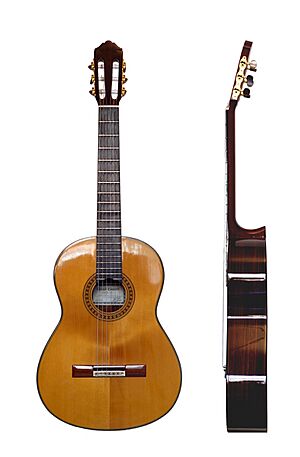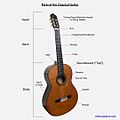Classical guitar facts for kids
A classical guitar, also known as a Spanish guitar, is a fantastic musical instrument. It belongs to a family of instruments called chordophones, which simply means it makes sound using vibrating strings. While it's most famous for its role in classical music played by talented classical guitarists, you'll also find it used in many other types of music! People have been playing instruments similar to the classical guitar for a very long time – possibly as far back as 4,000 to 5,000 years ago.
Contents
What is a Classical Guitar?
A classical guitar is an acoustic guitar, meaning it doesn't need electricity to make sound. Its body is hollow, which helps to make the sound louder when the strings vibrate. It usually has six strings, which are often made of nylon. These strings give the classical guitar its warm, mellow sound.
How Does it Make Sound?
When you pluck a string on a classical guitar, it vibrates. These vibrations travel through the bridge to the top of the guitar, called the soundboard. The soundboard then vibrates, pushing air inside the guitar's body. This makes the sound louder and sends it out through the sound hole, so everyone can hear the beautiful music!
Parts of a Classical Guitar
Just like any instrument, a classical guitar has different parts that work together.
- Headstock: This is at the very top, where the tuning pegs are.
- Tuning Pegs: These are used to tighten or loosen the strings, which changes their pitch.
- Nut: A small piece of material that holds the strings in place at the top of the neck.
- Neck: The long part of the guitar that you hold with your fretting hand.
- Fretboard: The flat part on top of the neck where you press down the strings.
- Frets: Metal strips on the fretboard that help you play different notes.
- Strings: Usually six nylon strings that you pluck.
- Body: The large, hollow part of the guitar that amplifies the sound.
- Sound Hole: The opening in the body where the sound comes out.
- Bridge: This holds the strings at the bottom of the guitar and transfers vibrations to the body.
- Saddle: A small piece on the bridge that supports the strings.
You can see these parts clearly in the diagram image below.
A Brief History of the Classical Guitar
The idea of stringed instruments has been around for thousands of years. Early versions of string instruments were played in ancient civilizations. Over time, these instruments changed and evolved. The modern classical guitar we know today developed in Spain during the 19th century. This is why it's often called a "Spanish guitar." Famous guitar makers like Antonio de Torres Jurado helped to design the classical guitar into the shape and size it is today.
Who Plays the Classical Guitar?
While the classical guitar is a star in classical music, it's also used in many other styles.
- Classical Music: This is where the classical guitar truly shines. Composers have written many beautiful pieces specifically for this instrument.
- Flamenco Music: A lively and passionate music style from Spain, often featuring fast strumming and rhythmic tapping.
- Jazz: Some jazz musicians use the classical guitar for its unique tone.
- Folk Music: Its warm sound makes it perfect for many folk songs.
- Latin American Music: The classical guitar is very popular in many Latin American countries, especially in traditional and popular music.
Many famous guitarists have played the classical guitar, including Agustín Barrios and Rafael Serrallet.
Images for kids
-
19th century guitar made by Manuel de Soto y Solares, held by Spanish guitarist Rafael Serrallet
-
Eminent classical guitarist and composer Agustín Barrios






